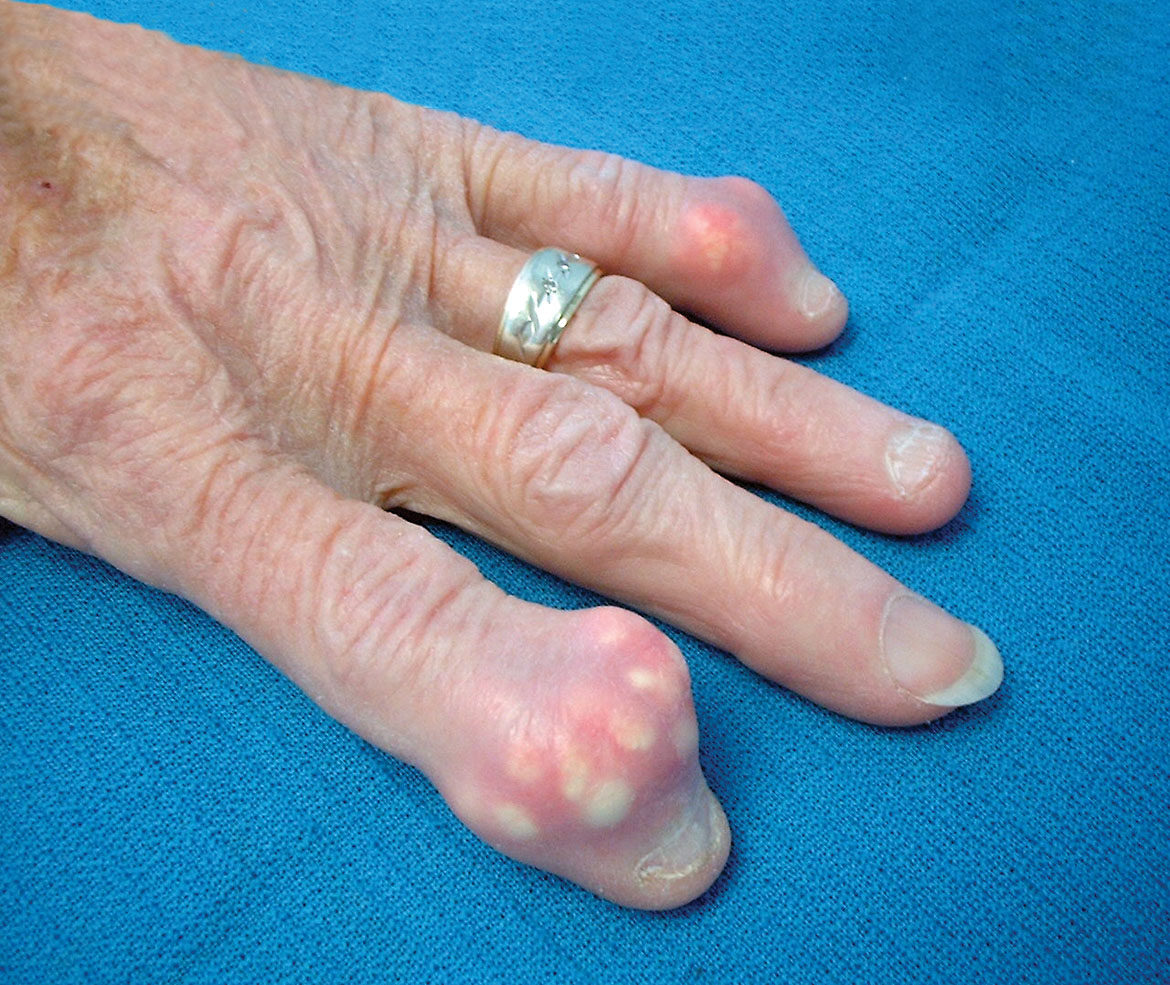gout in fingers treatment

gout is an inflammatory disease in which monosodiumurate crystals deposit into a joint, making it red, hot, tender and swollen within hours. when this happens, it’s called a gouty attack. the underlying cause is hyperuricemia—toomuch uric acid in the blood, which results in the formation of sharp, needle-like crystals,in areas with slow blood flow like the joints and the kidney tubules. over time, repeated gouty attacks can causedestruction of the joint tissue which results in arthritis. to understand where the uric acid comes from,let’s start with purines, which, together
with pyrimidines, are nature’s most commonnitrogen-containing heterocycles. a heterocycle being any molecular ring orcycle with different types of atoms. purines, as well as pyrimidines, are key componentsof nucleic acids like dna and rna, and when cells, along with the nucleic acids in thosecells, are broken down throughout the body, those purines are converted into uric acid—amolecule that can be filtered out of the blood and excreted in the urine. uric acid has limited solubility in body fluids,though. hyperuricemia occurs when levels of uric acidexceed the rate of its solubility, which is about 6.8mg/dl.
at a physiologic ph of about 7.4, uric acidloses a proton and becomes a urate ion, which then binds sodium and forms monosodium uratecrystals. these crystals can form as a result of increasedconsumption of purines, like from consuming purine-rich foods like shellfish, anchovies,red meat or organ meat. also, though, they can result from increasedproduction of purines, for example high-fructose corn syrup containing beverages could contributeto the formation of uric acid by increasing purine synthesis. another way crystals could form is from decreasedclearance of uric acid, which can result from dehydration from not drinking enough wateror from consumption of alcoholic beverages,
both of allowing uric acid to precipitateout. regularly eating these kinds of foods canalso lead to obesity and diabetes, both of which are risk-factors for gout. hyperuricemia can also develop as a resultof chemotherapy or radiation treatment, since cells die at a faster-than-normal rate. also, some individuals have a genetic predispositionto overproduction of uric acid while others with chronic kidney disease may be unableto excrete the uric acid. finally, there are some medications like thiazidediuretics and aspirin which can also increase the levels of uric acid and therefore therisk of gout.
now gout most often affects the first metatarsaljoint of the foot—or the base of the big toe, and when it does, this condition is calledpodagra. classically in podagra, a person will wakeup from sleep feeling like their big toe is on fire; even the weight of the sheets canbe painful. the pain is most severe in the hours immediatelyfollowing the attack and then generally lessens over time, but that discomfort and swellingcan last for days or weeks. gout can affect other joints as well likethose in the ankles, knees, wrists, and elbows. this inflammation and local pain’s ultimatelycaused by white blood cells, or leukocytes, which migrate to the site to help eliminateuric acid and release proinflammatory chemicals,
including cytokines. treatment of a gouty attack is typically focusedon decreasing the pain and swelling, most often with nonsteroidal anti-inflammatorymedications, or nsaids, like ibuprofen or naproxen sodium, but occasionally with corticosteroidsas well. colchicine which has anti-inflammatory effectsby inhibiting white blood cell migration has also been used for a long time to treat goutyattacks. to treat the underlying cause of increaseduric acid, though, it’s important to modify the diet, doing things like staying well hydrated(with water), reducing or eliminating soda, alcohol, red meat, and seafood, and stayingactive to ward off obesity.
there are also medications that help to decreaseuric acid levels, which include xanthine oxidase inhibitors like allopurinol. xanthine oxidase is an enzyme involved inthe breakdown of purines to uric acid, so inhibiting this enzyme results in less uricacid production. uricosuric medications, like probenecid, increaseexcretion of uric acid by the kidneys. over time, repeated gouty attacks can developinto chronic gout, which is a type of arthritis with joint tissue destruction and permanentjoint deformity. chronic gout can eventually lead to permanentdeposits of urate crystals—called tophi, which form along the bones just beneath theskin.
individuals with chronic gout are also atan increased risk for developing kidney stones made of uric acid, as well as urate nephropathy,which is when urate crystals deposit in the interstitium of the kidney. okay, as a quick recap, gout is a type ofinflammatory disease that typically affects the first metatarsal joint, which is the baseof the big toe, where uric acid precipitates to form monosodium urate crystals, which depositin the joint lead to inflammation and pain. thanks for watching, you can help supportus by donating on patreon, or subscribing to our channel, or telling your friends aboutus on social media.
